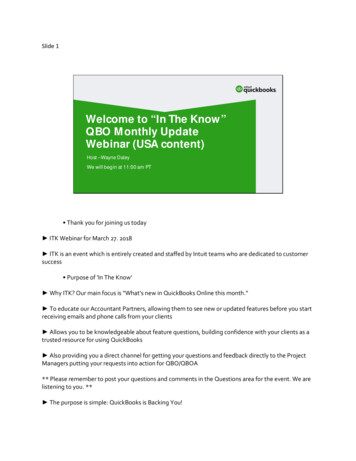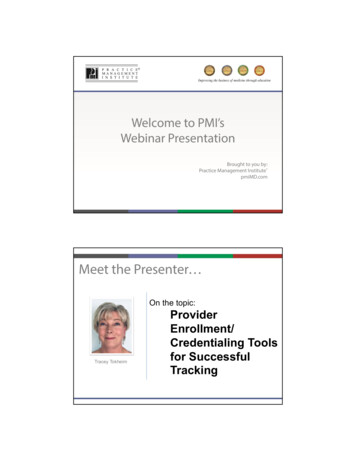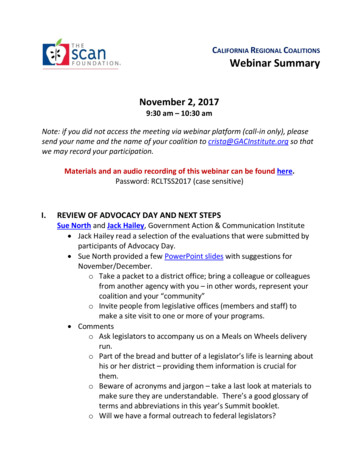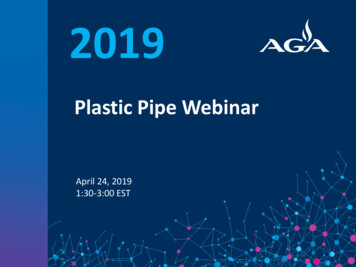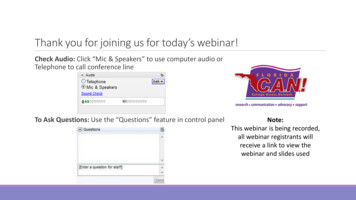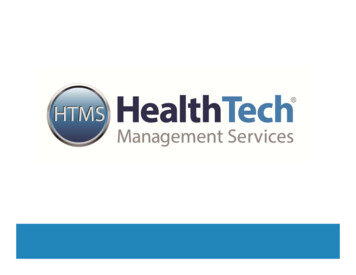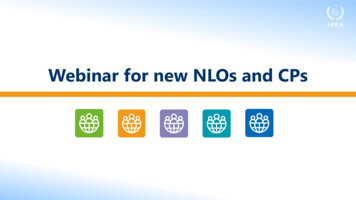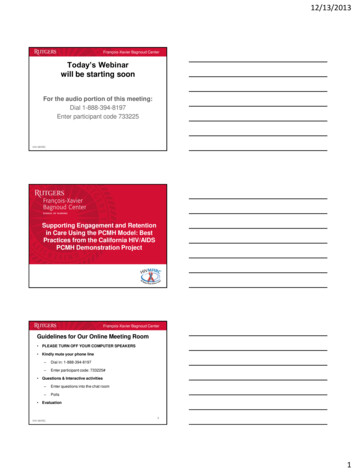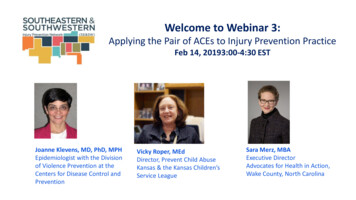
Transcription
Welcome to Webinar 3:Applying the Pair of ACEs to Injury Prevention PracticeFeb 14, 20193:00-4:30 ESTJoanne Klevens, MD, PhD, MPHEpidemiologist with the Divisionof Violence Prevention at theCenters for Disease Control andPreventionVicky Roper, MEdDirector, Prevent Child AbuseKansas & the Kansas Children’sService LeagueSara Merz, MBAExecutive DirectorAdvocates for Health in Action,Wake County, North Carolina
The Pair of ACEs Webinar tion/sesw-ipn/sesw-ipn-webinar-archive/ Webinar 1: Introducing the Pair of ACEs to Injuryand Violence Prevention Webinar 2. Using and finding data and engagingwith partners Webinar 3. Applying Pair of ACEs to injuryprevention practice
National Center for Injury Prevention and ControlAdverse Childhood Experiences and Adverse CommunityEnvironments: The Pair of ACEs Approach to InjuryPrevention PracticeJoanne Klevens, MD, MPH, PhDDivision of Violence PreventionSoutheastern and Southwestern Injury Prevention NetworkFebruary 14, 2019The conclusions in this presentation are those of the author and do not necessarily represent the officialposition of the Centers for Disease Control and Prevention.
ACE Score and Life Potential0Adjusted Odds Ratio31234 or moreACE Score2.521.510.50High School NoncompletionUnemploymentHousehold Poverty StatusMetzler, Merrick, Klevens, Ports, & Ford (2017). Adverse childhood experiences and life opportunities: Changing the narrative. Child Youth Serv Rev72:141-149
Assuring safe, stable, nurturingrelationships and environments for all childrenSafeStableNurturing
CDC’s Essentials for Childhood Framework Raise Awareness and CommitmentUse Data to Inform ActionCreate the Context for Healthy Children andFamilies through Norms Change and ProgramsCreate the Context for Healthy Children andFamilies through dmaltreatment/essentials.html
World Health Organization’s Social Determinants of HealthFramework to address inequitiesCommission on Social Determinants of Health. (2010). A conceptual framework for action on the social determinants of health. Geneva: World HealthOrganization.
Using WHO framework to reduce inequities in pair of ACEsPoliciesStrengthen householdeconomicsMaterialconditions Child support passedthru Tax credits Stronger safety netFamily-friendly work Livable wages Paid leaveEarly care andeducation Inequities by income race/ethnicitySocietal valuesSTRUCTURAL DETERMINANTS % in concentrateddisadvantage % children in poverty % homeless children % food insecurity parental stress parental depression partner conflictINTERMEDIARY DETERMINANTSCommunity organized and changing the narrativeACEs & THEIR INEQUITABLEBURDEN% children with 2 ACEs 3.9 x in lowest income group vhighest 1.8 x among black children vwhiteServices MIECHV reach % CBCAP for Evidence-Basedprograms Parent training Screening parents (SEEK)
CDC Funded 5 State Health Departments from 2013-2018 California Colorado Massachusetts North Carolina Washington30 Self Supported States – participated in initiative in some waySpecial issue of the International Journal on Child Maltreatment: t/page/1
Successes Strategic partnerships Shared understanding and new narrative Increase in % CBCAP and state invested inevidence-based programs in funded states 26 policies supportive of families passed from 2016to 2018 (average of 5.2 in funded v 0.7 in selfsupported v 0.2 in not engaged)Wasilewski, Shaw, & Hawley (2019). Accomplishing Great Things Together: A Cross-State Synthesis of Essentials for Childhood Grantees’ Efforts toPrevent Child Maltreatment. International Journal of Child Maltreatment available at: t/page/1
Challenges Complexity of the problem and solutions Long planning process to get to shared agenda& shared metrics Limited resources Individualistic mindset- fixing parents orchildren instead of changing the context toprevent it from happening in the first place
Visit CDC’s National Center for Injury Preventionand Control web site: www.cdc.gov/ncipcVisit the Division of Violence Prevention’s ACE web site:www.cdc.gov/violenceprevention/acestudyVisit our ACE Online Resources:vetoviolence.cdc.gov/apps/phl/images/ACE Accessible.pdfvetoviolence.cdc.gov/apps/aces/For more information, contact CDC1-800-CDC-INFO (232-4636)TTY: 1-888-232-6348 www.cdc.govThe findings and conclusions in this report are those of the authors and do not necessarily represent theofficial position of the Centers for Disease Control and Prevention.
Working “Upstream” to PreventAdverse Childhood Experiences(ACEs)Southeastern and Southwestern Injury Prevention NetworkFebruary 14, 2019
Seven state health departments selectedto prevent child abuse & neglectStrategyApproachStrengthen economic supports tofamilies-Strengthening household financial security-Family-friendly work policesChange social norms to support parents& positive parenting-Public engagement & education campaigns-Legislative approaches to reduce corporal punishmentProvide quality care & education earlyin life-Preschool enrichment with family engagement-Improved quality of childcare through licensing & accreditationEnhance parenting skills to promotehealthy child development-Early childhood home visitation-Parenting skill & family relationship approachesIntervene to lessen harms & preventfuture risk-Enhanced primary care-Behavioral parent training programs-Treatment to lessen harms of abuse & neglect exposure-Treatment to prevent problem behavior & later involvement inviolencePREVENTING CHILD ABUSE & NEGLECT
The KS Essentials for Childhood InfrastructureLeadership Team: Kansas Dept. of Health andEnvironment, Kansas Children’s Service League asthe Prevent Child Abuse Kansas Chapter, and WichitaState University Community Engagement InstituteSteering Committee: Kansas Power of the Positive2 Work Groups:Raising AwarenessKids Are Good Business
Leadership Team Strengths Kansas Dept. of Health and Environment Injury and Violence Prevention Connections with other Bureaus (Community Health, Family Health) Data for Project Evaluation (National Immunization Survey, WIC Program Participant Data,Protective Factors Dashboard) Data for Communities (Hospital Codes, Health Surveys) BRFSS ACE Module Data Website, Communications Kansas Children’s Service League Prevent Child Abuse Kansas Networks, PartnersBoard of Directors (Business People Already Engaged in Cause)Connections to Private FundingEducation and Awareness, AdvocacyMarketing, Messaging Wichita State University Community Engagement Institute Evaluation (KU Community Checkbox, Social Network Analysis, Partner Survey, SocialNorms Survey) Facilitation (Community Engagement) Other Grant Project (Resource Guide) Research (Beta Testing Employee Survey, Creating Guide)
Kansas Power of the Positive (KPoP)Partnering AgenciesooooBusiness Alliance for Childhood EducationCatholic Charities of KansasChild Care Aware of KansasChildren’s Alliance of KansasooooooFamily ConservancyJunior League WichitaKansas Action for ChildrenKansas Attorney General’s OfficeKansas Chapter of Academy of PediatricsKansas Chapter of Circle of ParentsoooooKansas Coalition Against Sexual & Domestic ViolenceKansas Department of Aging and Disability ServicesKansas Department for Children & FamiliesKansas Department of Commerce Business InnovationKansas Department of Health and Environmento Children’s Mercy Hospitalo DCCCAooooooKansas Chapter of Healthy Families AmericaKansas Chapter of Prevent Child Abuse AmericaKansas Child Advocacy CentersKansas Children’s Cabinet and Trust FundKansas Children’s Service LeagueKansas Court Appointed Special AdvocatesooooKansas Head Start AssociationKansas State Child Death Review BoardKansas State Department of EducationKansas State Extension OfficesooooooNon-Profit Chamber of Service, WichitaNorton Community FoundationOffice of Judicial AdministrationPrevent Child Abuse AmericaREACH Healthcare FoundationReaching Out From WithinooooWesley Children’s HospitalWestar EnergyWichita Coalition for Child Abuse PreventionWichita State University Community Engagement Instituteo Lumen Toucho Morris Family FoundationooooooSt. Francis MinistriesUnited Methodist Health Ministries FundUniversity of Kansas-Center for Public Partnerships & ResearchUniversity of Kansas-School of Social WelfareUniversity of Kansas-School of MedicineWashburn University School of Social Welfare
Common VisionAll Kansas children live in safe,stable, nurturing relationshipsand environments
CommunityChangeKansas Power ofthe Positive Actions Delivery of information Media Coverage New Partnerships New or modifiedprogram, policy orpractice within thesystemSafe, Stable,NurturingRelationshipsandEnvironments
Strengthen Economic Supports for FamiliesState Modifies how TANF Benefits are affected by child supportpayments (p. 13) Facilitates SNAP access (p. 13) Administrates HUD differently (p. 14) Expands child care subsidy (p. 14)Organizations Help families access EITC (p. 13) (Wichita Coalition)Family-friendly Work Policies/Employers Offer livable wages (p. 14) Offer paid leave (p. 14) (Family Conservancy) Offer flexible and consistent schedules (p. 14)
Change Social NormsOrganizations Use communication strategies to reframe the way people thinkand talk about child abuse and neglect, focusing on contextualcauses and societal solutions (p. 18) (Wichita Coalition w/Media, Pittsburgh ABC Affiliate) Promote social norms related to child development and safety(p. 18) (Wichita Coalition Safe Haven Campaign)State Law Limits corporal punishment (p. 18) (Dr. Robert Sege was akeynote at Governor’s Conference to Prevent Child Abuse andNeglect the week he released the AAP report; discussed this)
Quality Early Care and EducationOrganizations Provide high-quality early childhood education and care todisadvantaged children (p. 21) (Expanded Pre-K)Child Care Providers Become accredited (p. 21)
Enhance Parenting SkillsOrganizations Provide early childhood home visiting programs (p. 25)(Received funding to serve additional 350 children) Provide parenting skill support and education (p. 25)(Advocating for Family First to increase parenting skillsupport and education)
Intervene to Lessen Harms and Prevent Future RiskOrganizations Provide therapeutic treatment to mitigate effects for childabuse and neglect (p. 29) (Increased Mental Health fundingfrom the State) Provide therapeutic treatment for problem behavior (p. 29)(Help Me Grow, Pre-K funding)Primary Care Providers Are trained to identify risk factors (p. 29) (The physicianworking on this is on our Coalition; she is an AAP BoardMember)
Education & Awareness: Educating Legislators KCSL and KDHE presented our Powerpoint to the differentcommittees of the Kansas legislature each year since 2013. Champions include our CEO, Lobbyist, Kansas Action forChildren, our parent leaders, key legislators and their spouses,our Board of Directors and Foundation Trustees, our SteeringCommittee and Leadership Team and our funders. Invited Legislators and Spouses to Site Visits at KCSL, BuildingHealthy Families Events. After our 2017 presentation, key legislators came up with theplan to re-direct funding to evidence-based home visiting. Then they came up with the plan to increase Pre-K funding. CAP Month 2018: proclamation, pinwheels, speech,commendations
Media and Messaging Wichita Coalition for Child Abuse Prevention Worked with Lynn Davey, CDC Consultant, to assist us withTalking Points for our Speaker’s Bureau Speaker’s Bureau: Prevent Child Abuse Kansas Chapter Child Advocacy Center CASA Child Abuse Pediatricians Key Hospital Staff on the Coalition Law Enforcement Utilize CDC’s “Suggested Practices for JournalistsReporting on Child Abuse and Neglect” in Media Kits
Community Changes Gov. Colyer signed an executive order to expand parentalleave for state employees.KSDE launched the KS Kindergarten Readiness Snapshot Toolthat collects Ages & Stages Questionnaires.The KS legislature amended the DCF SFY 2018 budget toinclude 3 million of the federal TANF block grant forevidence-based home visiting, an additional 350 children willbe served.Help Me Grow has selected 3 initial communities for theirproject of identifying children at risk for developmentaland/or behavioral problems and linking them to services.On Feb. 9, 2018 Congress passed the bipartisan spending billwhich authorizes MIECHV. Five of the six Kansas delegationvoted in favor.
Community Changes Continued After viewing “The Raising of America”, Family Conservatorychanged their Paid Parental Leave policy to accrue 12 weeks ofpaid medical leave in 18 months instead of 3 years.In response to a request from the Chairman of the Reaching OutFrom Within inmate-run self-help program at the LansingCorrection facility, Minimum Security Unit, a four week coursedesigned for members was created. The ACE Study, the TraumaInformed material and the 10 Question ACE Survey is part of thecourse.WSU integrated ACE information and Kansas ACE Data into a fullday training for community providers connected to KDADs.KDHE released its Kansas BRFSS ACE Module Reports . The reportdemonstrates the link between ACEs and health status later in life.KDHE added the ACE module to the Kansas BRFSS . This is the firsttime Kansas gathered information about adverse childhoodexperiences.
Fostering Family SuccessHOW CAN WEENSURE THATCHILDREN HAVE Ao Members support family-friendlypolicy changeo When families are successful,children are successfulo When children are successful,it's positive for everyone.SAFE, STABLE,NURTURINGENVIRONMENT INWHICH TO GROW?
Kansas3.4%unemploymentrate50,000openjobsmoving low income into the workplacethese workers need support to be successful& remain in the workplaceGOAL self-sufficiency
Strong FAMILIESbuildStrong BUSINESS
Family-friendlyworkplace policies& practicesKPoP invites business to beallies in building protectivefactors around Kansas childrento increase their bottom line.
Kids are goodbusinessSteps in helping workplaces implement new policies & practices tocreate conditions that allow working parents to provide safe,stable, nurturing environments for their children:SURVEY helps employers understand how families are impactedby different workplace policies & practices;SURVEY identifies high priority conditions important to staff &might need improvement.RESOURCE GUIDE gives employers concrete resources for creatingthose conditions.
Six EmployersBeta-Tested SurveyFollow up interviewresults:oReport is easy tounderstandoReport helps withprioritizationoWould make changesas a resultoEasy to administeroEasy to respond“Helps you understandwhat your team isfeeling and how youcan be supportive”
Employee survey asks two questionsHow important are the following conditions for your ability toprovide a safe, stable, nurturing environment for yourchild(ren)? When thinking about your answers, please thinkabout your own family needs.o Reports average importance to staffHow would you rate your workplace on meeting the needs ofworking parents in the following areas? When thinking aboutyour answers, please think about the needs of all the familiesat your workplace.o Reports average workplace rating
The two questions refer to a list of 19 workplaceconditions that contribute to FOUR GOALS:1.Increased access to high-qualitychildcare3.Increased socioeconomicresources for the family2.Increased safe, stable, nurturingrelationships & environments forchildren at home4.Increased integration of family,school & community efforts
Essentials for ChildhoodSHORT-TERMOUTCOME:Employers ctorsINDICATORS:
Engaging KCSL Board of Directors inKansas Essentials for Childhood ProjectKansas Children’s Service League is thePrevent Child Abuse Kansas Chapter witha 24 member Board of Directors and 24members on Foundation as Trustees.Most are current employees or retiredfrom the business sector with an interestin preventing child maltreatment.
Next StepsMake decisions about moving thework of the Kids Are Good Businesssurvey forwardExploring work with 2 board memberprojects (urban & rural)
THANK YOU!Vicky Roper, Prevent Child Abuse Kansas DirectorKansas Children’s Service League(316) 942.4261 vroper@kcsl.org
ACEs Resilience InitiativeWake County, North CarolinaS ARA ME RZE X ECUTIVE DIRECTORADVOCAT ES FOR HEALTH IN ACTION (AHA)SE & SW Injury Prevention Network Webinar, 2.14.19
Brief History ofACEs Resilience in Wake County Initiative Began conversations with County Manager April, 2017 AHA partnered with Wake County and the YMCA of the Triangle to launch the firstscreening of Resilience and a community discussion of ACEs and resilience with 300 inattendance Huge interest and a strong desire to do something Advocates for Health in Action (AHA) improves the health and well-being of Wake Countyresidents by facilitating and supporting community initiatives Strength is on convening partners, mobilizing the community Working to change policies, systems, and environments focused on healthy eating, physical activityand now, well-being AHA Board decided to expand their work to address ACEs and build resilience
Brief History of the Initiative 12/5/2017: Building ACEs Resilience:What’s Working in Wake County 275 attendees
Public Screenings of Resilience
Structure of the Initiative Honorary Co-Chairs: Wake County District Attorney and former newspaper publisher Advisory Board (representing 32 agencies/organizations) Steering Committee (representing 64 agencies/organizations) 4 Work Groups (50 people actively engaged) Helpers and ProvidersCommunity MembersEducatorsPolicy Makers Consultant support to establish use of the Results Framework Full-time coordinator funded by Wake County, hired August 2018
InitiativeStructure
Evaluation: Results Framework
Successes Lots of county residents are now aware of ACEs and resilience; many are engaged; over 6000have seen a screening of Resilience January 15, 2019: From AWARENESS to ACTION: Building a Resilient Wake County through aTrauma-informed Approach 300 attended keynote 200 stayed for a more in-depth training Examples Town of Cary Wake County leadership and agencies
Lessons Learned Big events are a good way to raise awareness and get folks involved, but there needs to be astructure to move them to action Holding public screenings of Resilience raises awareness and interest; the key is to have facilitateddiscussions afterwards with tangible ways the audience can get involved 50 organizations have borrowed DVDs to screen for their boards and staff; follow up is determining actionplans. Huge desire for training in trauma-informed approaches to drive new policies and practices Organizations know their own systems and know what fits for them. There is a desire for convening support, presentations and for support in “co-creating” next steps Screenings linked to community resources are powerful Simplify structure – three leadership bodies are too many; most happens in the Work Groups It’s community organizing that makes this successful. Any organization with expertise in conveninggroups and mobilizing communities to action can do this. Subject matter expertise exists in thecommunity and can inform content and direction of the movement.
Thank you!Sara MerzExecutive DirectorAdvocates for Health in Action (AHA)smerz@wakeaha.org919-368-3418Lisheema BarrACEs Resilience Project Coordinatorlbarr@wakeaha.org919-328-0055
The Pair of ACEs Webinar Serieshttps://iprc.unc.
Wasilewski, Shaw, & Hawley (2019). Accomplishing Great Things Together: A Cross-State Synthesis of Essentials for Childhood Grantees’ Efforts to . Kansas Court Appointed Special Advocates o Kansas Coalition Against Sexual & Domestic Violence o . Reporting on Child Abuse and Neglect”
